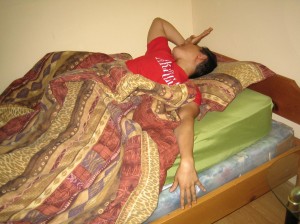What is a migraine?
Migraine headaches create incapacitating pain and suffering in their victims. Today, nearly 30 million citizens of the United States suffer from these disabling headaches that even physicians have difficulty treating.
Migraine too may include other more broadly encompassing symptoms that may occur either before the onset of the headache, or later.

Symptoms of the Migraine
Most sufferers report the onset begins with a throbbing headache. It may be severe or only moderate at the beginning, and may last not only for hours, but for days.
A migraine headache may also be preceded by an aura.
Typically, the center of pain may be located over one eye or temple. Sometimes the center will be at the back of the head or it can even involve both sides of the head. Migraines and their pain centers can be quite unpredictable.
A migraine sufferer may experience nausea and extreme sensitivity to light and noise. And generally, a migraine incapacitates the patient so severely that it is difficult if not impossible to continue usual activities either at work or for pleasure.
Who gets Migraine?
Up to fifteen percent of adults get migraines, and unfortunately, migraines appear to run in families. They often begin during childhood, and children of either sex may be equally susceptible. However, after having reached puberty, men are two to three times less likely to suffer from migraines than are women. It is thought that the female hormones may play an important role in triggering migraines. One indication favoring this theory is that many migraine sufferers get migraines, or more severe migraines at or around the time of their periods or ovulations, a time when female hormones are fluctuating more actively than usual.
What Causes Migraines?
Many factors known to trigger migraines, such as sleep deprivation, certain food products, etc., are not believe to actually trigger a migraine on their own, but do tend to aggravate it. Many now believe that susceptible persons tend rather to suffer from a chemical signal that may trigger pain sensors along the trigeminal nerve. This nerve supplies the tissues of the cheeks, jaw and forehead. The chemical signal from the trigeminal nerve may cause:
Inflammation of blood vessels in the head.
Widening of blood vessels I the head.
This process may also irritate local nerve fibers, sending pain signals back to the brain. Some also believe that the brain chemical serotonin may play a part in this process.
Migraine Triggers
Most sufferers are aware of the trigger factors that threaten the onset of an attack. These may include lack of sleep, stress, and certain foods as well. While migraine trigger factors aren’t believed to actually cause the onset of a migraine on their own, they can however, trigger the processes that in turn lead to a development of another migraine in the person who suffers from them.
A number of different migraine triggers may exist for one migraine sufferer. Many physicians suggest keeping a diary so that the patient may possibly find a system to help become more aware of triggers that could possibly be avoided.
Some are exposed to more than one trigger at a time. This can produce a more pressing effect that hurries the onset of the migraine. As mentioned above, women who get migraines are more likely to suffer during their periods, while exposure to other triggers around this same time, such as lack of sleep, alcohol, and other possible causes, may make the migraine even more likely and severe. During other parts of the month, alcohol alone may not bother the person who might otherwise be prone to migraines.
Physicians know of course, that it is almost impossible for a sufferer to avoid all triggers at all times. However, the greatest favor the sufferer can do to lessen these ordeals is to become aware of the triggers and keep them in mind at all times. This can, at least in part, help the sufferer manage and, at times, prevent a migraine.